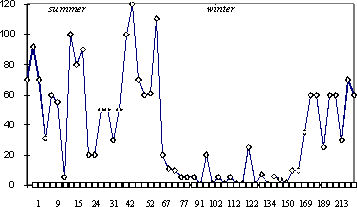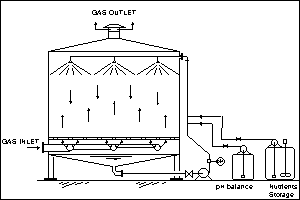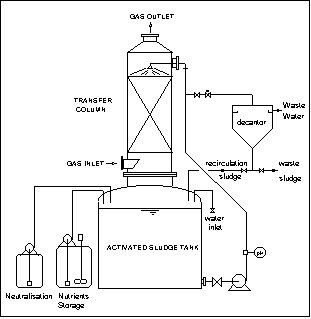|
|
Summary Page - Biological Processes
If you wish to know more about any of these products, you may request further information through our online enquiry form
|
1 - FIXED BIOMASS
Biofilter using organic filter media
In all types of biofilter, the bacteria in the filter bed degrade the pollutants as the gas percolates through the biofilter media. These bacteria are either present naturally or introduced by seeding prior to the filter use. The degradation of pollutant is achieved through aerobic digestion.
A timed spraying device helps maintain moist conditions required by the microorganisms and also allows the introduction of nutrients.
|

|
Biofilters using organic filter media have been used for more than 10 years to treat low strength odours in the case of gases loaded with nitrogenous compounds (ammonia, amines) or sulphur compounds (hydrogen sulphide, mercaptans). In the case of concentrations lower than 20 milligrams per cubic metre, the removal efficiency can be greater than 99%.
This traditional type of biofilter, however, is seldom used by Hibernia due to its large space requirement and its need for frequent bed replacement.
|
|
|
....
|
Biofilter using Inorganic Media
This new generation type of "Biofilter" that uses non-organic media has been developed and patented by Hibernia ETH Ltd. In this system, Hibernia ETH Ltd. uses a high performance inorganic media derived from Calcified Seaweed and called LCP-11X. Biofilters using High Performance LCP-11x media can be seen to exhibit the following advantages:
- Higher Overall Performance which greatly reduces the physical size of the Biofilter and the associated hardware
- Superior Hydrogen Sulphide "Peak" removal even at concentrations of greater than 100 ppm.
- No acclimatisation period requirement after plant shutdown or operational mishap
- pH stable with no H2SO4 acid run off
|

|
LCP-11X media is derived from Calcified Seaweed and other essential components. It is a 100% natural material with a large surface are that gives improved biological activity at low back pressure.
This large surface area also allows a considerable reduction in the actual volume
of media required.
|

|

|



|
Very High Performance, with 100% removal of
Hydrogen Sulphide Peaks and no acclimatisation
|
|
As the polluted air passes over the biofilter media, the bacteria developed in the media bio-layer degrades the pollutants through a process of adsorption and aerobic digestion.
A simple irrigation system is generally incorporated to maintain the appropriate "climate" within the filter that best supports the various micro-organisms present.
|
|
|
....
|
Trickling Biofilter
This system is different from the previous one in that:
- The support is inert and made from materials having a very high porosity
- There is a constant wetting of the filter through recirculation of the washing liquid and the nutrients
- The gas velocity is higher, which allows the filter to be more compact
|

|
|
These new devices can now degrade VOCs of low solubility, provided they are present in low concentration.
|
|
|
....
|
2 - CIRCULATING BIOMASS
Bioscrubber
This process consists of the transfer of the gas pollutants into a liquid, using a physical contact achieved by a column or a Venturi. The degradation of the pollutants is then carried out in the liquid phase, in a biological reactor.
The excess biomass is separated from the recirculating liquid by decantation before being returned to the scrubber.
|

|
|
This type of equipment can eliminate highly concentrated compounds (up to 1 gram per cubic metre). It can also be applied to pollutants which are easily biodegraded when their treatment by a fixed bed filter would result in a blockage of the filter.
|
|
|
|
- top of page -
|
|

